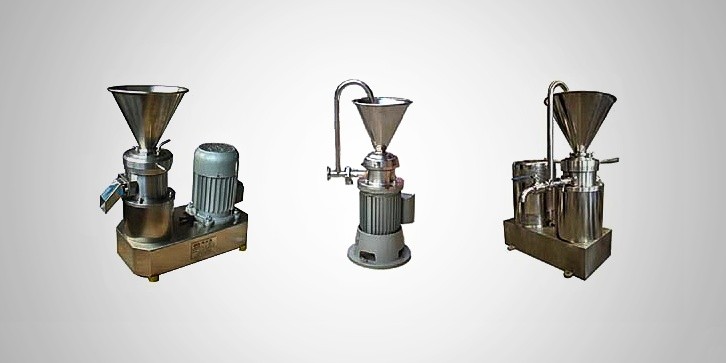Table of Contents
Principle of the Colloid mill
The colloid mill consists of two steel discs having very small clearance between them. One disc is rotating, while the other one is stationary. When the material is passed through these discs, they get sheared. Thus, coarse particles are broken down into small particles due to shear.
Construction of the Colloid mill
The construction of a colloid mill is shown in Figure 1.1. The mill consists of a high-speed rotor and stator with a conical milling surface. The milling surfaces may be smooth-surfaced or rough-surfaced. Rough surfaced mills are used for fibrous material because fibers tend to interlock and clog smooth-surfaced mills. The clearance between rotor and stator can be adjusted from 0.05 to 0.75 millimeters. During milling, the heat generated may raise the temperature up to 40°C. Hence, cold water circulation is provided to reduce the temperature by as much as 20°C. The discharge pipe is also connected to the hopper, so that discharge can be recycled.

Working the Colloid mill
Materials for the manufacture of suspensions and emulsions are placed in the hopper. Usually, the solids are pre-milled to prevent damage to the colloid mill. The solids are mixed with the liquid vehicle before introducing into this mill. The dispersion flows down and adheres to the rotor. During the movement of the rotor (3000 to 20000 revolutions per minute), centrifugal force throws a part of the dispersion onto the stator. Depending on the clearance, the dispersion is sheared between the rotor and stator. Thus, size reduction can be achieved. The milled liquid may be recycled. After achieving the desired size, the discharge is collected from the outlet in the periphery of the housing.
Normally, the size of milled particles may be smaller than the clearance, because of the force of high shear. In emulsification, a clearance of 75 µm may produce dispersion with an average particle size of 3 μm. The capacities of colloid mills range from 2 to 3 L/min for small mills to 440 L/min for larger mills.
Uses: This mill is used for preparing colloidal dispersions, suspensions, and ointments. Particle sizes as small as 3 um can be obtained. The fibrous material can be milled using a rough-surfaced rotor and stator.
Advantage:
- The colloid mill can be sterilized. So it can be used in the production of sterile products.
Disadvantages:
- The colloid mill tends to incorporate air into the finished product. Therefore, the product should be allowed to rest for some time for deaeration.
- Heat is generated during milling. Hence, a water circulation facility around the milling chamber has to be provided.
- It is not useful for dry milling.
Make sure you also check our other amazing Article on : Fluid Energy Mill
